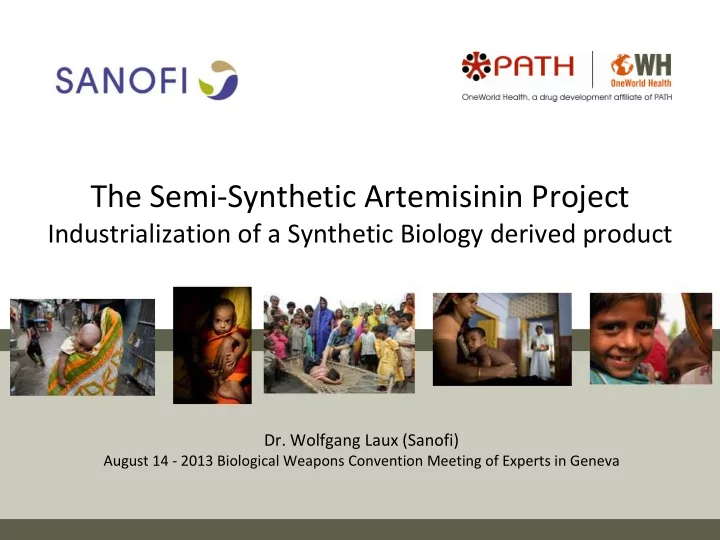

The Semi ‐ Synthetic Artemisinin Project Industrialization of a Synthetic Biology derived product Dr. Wolfgang Laux (Sanofi) August 14 ‐ 2013 Biological Weapons Convention Meeting of Experts in Geneva
Malaria & Artemisinin – Malaria most prevalent in subsaharan Africa, south and south ‐ east Asia • One third of world population living in affected areas • In 2012: 219 million cases, 660,000 deaths – Increasing resistance to « classical » medication – Artemisia annua known since more than 2000 years in Chinese medicine – Artemisinin isolated/identified 1972 – 2004: WHO recommends artemisinin based H combination therapies (ACT) as standard O O O therapy for uncomplicated Malaria H H – Demand increase from 50 t/a to appr. 200 O t/a over last 10 years O 2
Semi ‐ synthetic Artemisinin Project Goals • Create a complementary source of non ‐ seasonal, high ‐ quality, and affordable artemisinin to supplement the current plant ‐ derived supply. • Cycle time reduction from 15 months to 3 months • Ensure semi ‐ synthetic artemisinin is available to all qualified derivative manufacturers. • Contribute to stabilizing the price of Photo: PATH/Laura Newman ACTs to benefit patients and payers. 3
Project History 2003: First Publication by J. Keasling et al. on the technology 2004: iOWH/Amyris/UC Berkeley Partnership & 1st BMGF grant 2005: Development phase started 2007: Sanofi ‐ Aventis partnership (industrial partner) 2008: Development phase completed 2009: Industrialization started, 2 nd BMGF grant 2011: Industrialization completed (first few 100 kgs produced) 2012: Validation on industrial scale, regulatory submissions 2013: Approval from WHO, Production at multi ‐ ton scale 4
Chemical Synthetic Conversions Simple Sugar Biology Acetyl-CoA Amorphadiene Microbially ERG10 Derived H ADS Acetoacetyl-CoA Artemisinin ERG13 H Oxidation and HMG-CoA AMO/CPR Ring-Closure tHMGR X2 H Mevalonate Dihydroartemisinic Acid Ester ERG12 H HO Hydroperoxide Mevalonate-P ADH1 ERG8 Peroxidation H H Mevalonate-PP ERG19 H Non-Enzymatic H H Dihydroartemisinic HO IDI1 HO IPP Acid Ester DMAPP O ERG20 ALDH1 GPP H Esterification ERG20 Artemisinic acid H FPP HO Dihydroartemisinic O erg9 ::P MET3 -ERG9 Met Acid Squalene H Reduction ERG1,7,11,24,25,6,2,3,5,4 Purification H HO Artemisinic acid Ergosterol O
Fermentation Part: Industrialization In 2008 strains were transferred from Amyris to Sanofi. – Development to meet industrial strain requirements • Reproducibility of different yeast strains • Banking (strain stability) – Optimization of fermentation performance • introduction of ethanol as second carbon source – Optimization of down ‐ stream process • Laboratory process could not be scaled up (foaming) • Use of one organic solvent for continuous extraction only (for recycling purpose) • Crystallization of product from water 6
Fermentation Part – A rtemisinic Acid Industrial Scale at Huvepharma (Bulgaria) H O OH HO H HO OH H HO OH O Glucose Artemisinic Acid Process development and industrial • scale-up completed. Facility and equipment are in place. • Routine Production Started • 2012: 38,7 t produced • 2013: Production of 60 t • targeted 7
Chemistry Part: Industrialization In 2008 lab process was transferred from Amyris to Sanofi. – Hydrogenation step (1) • Catalyst changed to a more selective one – Activation/Esterification step (2) • New activation group introduced to facilitate following steps – Photochemical Oxydation steps (3/4) • Process changed completely • Photochemical process with concatenation of oxydation and rearrangement reactions • Chromatography skipped during work ‐ up – Overall yield almost tripled (19 % → 55+ %) 8
Chemistry Part – Semisynthetic Artemisinin Industrial Scale in Garessio (Italy) H H O H O O H H H O HO O O Artemisinic Acid Artemisinin Process development and industrial • scale-up completed. Facility and equipment are in place. • Routine Production Started • 2013: Production of 35 t • targeted 2014: Capacity of 50-60 t • 9
Conclusion • Shows that innovative technologies (like synthetic biology) can be implemented industrially rather quickly and can thus promptly contribute to global health. • From Lab realization to Industrial scale incl. regulatory approval in about 10 years. Industrialization phase: about 4 years • Rather complex process – fermentation step & chemical steps • Partner with large network of industrial technologies/facilities and expertise is at least helpful if not necessary to realize such a project. • Sanofi group: Overall 112 industrial sites in 41 countries • 16 sites in Chemistry & Biotechnologies (active ingredient) • 10 sites in vaccine production (Pasteur) • More than 40.000 employees in Production 11
Conclusion • Success story of cross ‐ sector partnership among industry, academia and nonprofit organization. • New commercial ‐ scale alternative manufacturing process to produce a complementary source of artemisinin and supplement the plant ‐ derived supply. • Pivotal milestone in the fight against malaria. 12
Thank You National Research Council Canada Plant Biotechnology Institute (NRC ‐ PBI) Photo: PATH/Laura Newman 13
Recommend
More recommend